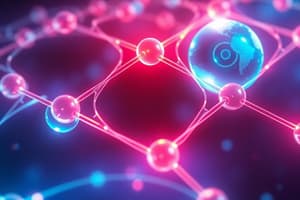Podcast
Questions and Answers
Resonance structures represent the actual electronic structure of a molecule, which is often a hybrid of the contributing ______
Resonance structures represent the actual electronic structure of a molecule, which is often a hybrid of the contributing ______
structures
Sigma bonds are the strongest type of bond that represents the 'glue' that holds the atoms together. They are the most ______ type of bond
Sigma bonds are the strongest type of bond that represents the 'glue' that holds the atoms together. They are the most ______ type of bond
strongest
Pi bonds in double bonds or triple bonds can move without destroying the connectivity and are denoted as ______ bonds
Pi bonds in double bonds or triple bonds can move without destroying the connectivity and are denoted as ______ bonds
pi
Unshared electron pairs or lone pairs represent the most mobile type of ______
Unshared electron pairs or lone pairs represent the most mobile type of ______
Electrons move towards areas of lower electron density and away from ______ charges
Electrons move towards areas of lower electron density and away from ______ charges
Bond energy calculates how strong the bond is, representing the energy required to break a covalent bond. It is measured in joules or kilocalories per ______
Bond energy calculates how strong the bond is, representing the energy required to break a covalent bond. It is measured in joules or kilocalories per ______
Metallic bonds have a ______ distance typically SHORTER THAN IONIC BONDS
Metallic bonds have a ______ distance typically SHORTER THAN IONIC BONDS
Electronegativity is the atom's ability to attract other shared electrons in a ______
Electronegativity is the atom's ability to attract other shared electrons in a ______
Non-polar Covalent bonds occur between ______
Non-polar Covalent bonds occur between ______
Polar Covalent Bonds occur between ______ atoms
Polar Covalent Bonds occur between ______ atoms
Ionic Bonds occur between ______ and non-metal ions
Ionic Bonds occur between ______ and non-metal ions
In Ionic bonds, it results in ______
In Ionic bonds, it results in ______
Flashcards are hidden until you start studying
Study Notes
Resonance
- Represents the actual electronic structure of a molecule, often a hybrid of contributing resonance structures.
Sigma Bonds
- The strongest type of bond, holding atoms together.
- Represent the "glue" that holds atoms together.
Pi Bonds
- Found in double bonds or triple bonds and can move without destroying connectivity.
Unshared Electron Pairs (Lone Pairs)
- Represent the most mobile type of electrons.
Electron Mobility
- Order of electron mobility: Unshared electron pairs (lone pairs) > pi-bonds > sigma bonds.
- Electrons move towards areas of lower electron density and away from negative charges.
Chemical Bonding
- Bond distance (bond length) refers to the spatial arrangement of atoms and is measured in picometers.
Bond Energy
- Calculates the strength of a bond, representing the energy required to break a covalent bond.
- Measured in joules or kilocalories per mole.
- Tends to increase from single to double to triple bonds.
- Higher bond energy indicates a stronger bond.
Bond Relationships
- Shorter bond distance = higher bond energy.
- Longer bond distance = lower bond energy (with exceptions due to variations in atomic properties and bond types).
Covalent Bonds
- Strongest and used as a basis in all organic molecules.
- Bond distance is usually short, indicating a close interaction between atoms.
Ionic Bonds
- Atoms gain and lose electrons later on.
- Bond distance is usually large, indicating a greater distance between atoms.
Metallic Bonds
- Bond distance varies, but is typically shorter than ionic bonds.
Electronegativity
- Ability of an atom to attract shared electrons in a bond.
- Used to predict the polarity of a bond.
Non-polar Covalent Bonds
- Occurs between non-metals.
- Electronegativity difference between atoms is very small (< 0.5).
- Equal or almost equal sharing of electrons between bonding atoms.
- Example: Cl-Br bond.
Polar Covalent Bonds
- Occurs between non-metal atoms.
- Electronegativity difference between atoms is moderate (> 0.5).
- Unequal sharing of electrons between bonding atoms.
- Example: Cl-C bond.
Dipole and Bond Polarity
- Dipole is the separation of charges in a polar bond.
Ionic Bonds
- Occurs between metal and non-metal ions.
- Results in electron transfer.
- Electronegativity difference between atoms is high (> 1.8).
- Example: N-Na bond.
Electron Bonding
- Non-polar Covalent: Electrons are equally shared.
- Polar Covalent: Electrons are shared unequally.
- Ionic: Electrons are transferred.
Studying That Suits You
Use AI to generate personalized quizzes and flashcards to suit your learning preferences.




